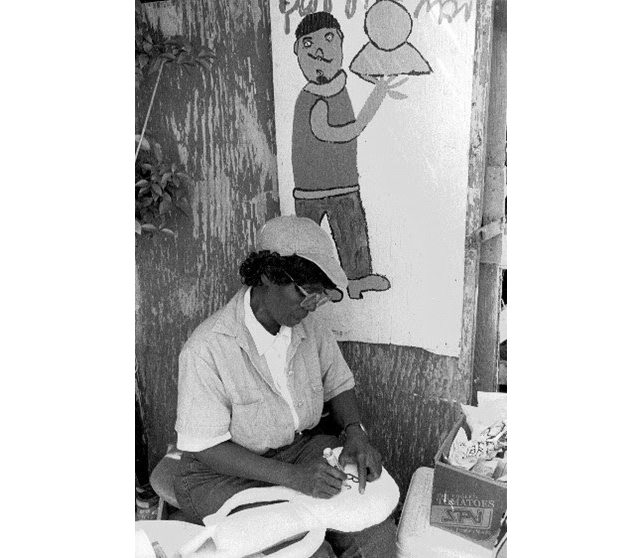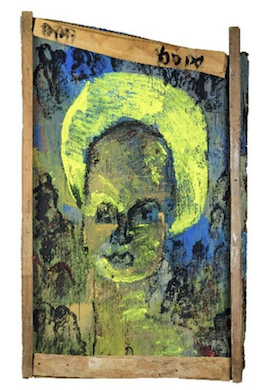
NEW YORK – There are many who live their entire lives without even thinking about lifting a pencil or wetting a brush outside of a school art class. But there are others who feel an innate compulsion to create art.
Their actions are not necessarily explicit or conscious. If you strode up to them and called them artists, or described their physical creations as artworks, some might arch an eyebrow, or laugh, or frown, or wave you off. Making art is simply something they feel they must do. Eat, sleep, make art, repeat.
They know little to nothing of the world of galleries. Museums are places that rich people and tour groups visit. They are unschooled in art, and may be unschooled entirely. Some might purchase their materials at an art store, but they’re just as likely to fashion them from whatever they have on hand, such as a paper bag, piece of cardboard or other “found objects.” They may create art to bring themselves closer to God, or because they couldn’t otherwise own any art, or because a deep-seated urge that is older than speech and deeper than the ocean tells them to. None of these creators takes the same artistic path, but scholars have applied a collective term to describe them: outsider artists. The fruits of their labors are known as outsider art.

The interest in outsider art began in the early 20th century with psychiatrists who studied artists who were institutionalized. In 1922, the book Artistry of the Mentally Ill became influential to the Surrealists. Later, in 1948, Jean Dubuffet and others founded the Compagnie de l’Art Brut, a collection of what they called “raw art,” or art made outside what they perceived to be the traditions of fine art.

Kathleen Goncharov, the Senior Curator of the Boca Raton Museum of Art, says: “This interest has recently increased exponentially, as more mainstream institutions celebrate these kinds of artists. ‘Outsider’ artists are now most definitely ‘in.’ Many controversial terms have been bandied about to describe them, such as self-taught (in addition to ‘outsider’), but no truly definitive name yet. I suggest we call all creative works that are arresting, intriguing, and interesting conceptually, as simply ‘art’ and leave it at that. Jean Dubuffet said it best when he declared that art’s best moments are when it forgets what its own name is,” said Goncharov. “Artists create – that’s what they do.”
The Highwaymen, also referred to as the Florida Highwaymen, were 26 African American landscape artists from Florida who were largely self-taught. Some were mentored or inspired by Albert Ernest “A. E.” Backus (1906-1990), also known as Beanie Backus, an American artist famous for his vivid Florida landscapes. The Highwaymen collectively created a body of work numbering more than 200,000 paintings. Mostly from the Fort Pierce area, they were known to paint their landscapes using construction materials rather than traditional art supplies, and made a living selling them door-to-door to businesses and individuals throughout Florida from the mid-1950s through the 1980s. They also peddled their work — often still wet — from the trunks of their cars along Florida’s eastern coastal roads, A1A and US1 — hence the name “Highwaymen.” They have been called “the last great American art movement of the 20th century.”
Up until 20 years ago, outsider art was not widely accepted as fine art. It wasn’t shown in museums, and professionals from the art world looked down upon it. “This challenges the primary beliefs of traditional art making and has added a lot to the plurality of art,” said Gary Monroe, a photographer and an expert on outsider artists in Florida. “Being surrounded by such a large collection of artworks made by self-taught artists is invigorating. Especially because of their visual resolve to express themselves without convention.”

These artists do not learn from their predecessors. Their works come from deep within themselves. Many of them dealt with deep emotional loss in their lives, and debilitating conflict. Yet at the same time they each experienced an overwhelming surge of creativity in their lives. “A lot of times, when going to see a museum or gallery show, the viewer experiences a sense of distance. Exhibitions can feel standoffish,” said Monroe. “Here, there is no distance between you and these self-taught artists. I think it’s because the work is so visceral. There’s no pretense whatsoever, no artifice, there are no rules.”
The artworks and artists pictured here, along with many others, appear in An Irresistible Urge to Create: The Monroe Family Collection of Florida Outsider Art, which is on view at the Boca Raton Museum of Art in Boca Raton, Florida until September 5.
# # #


